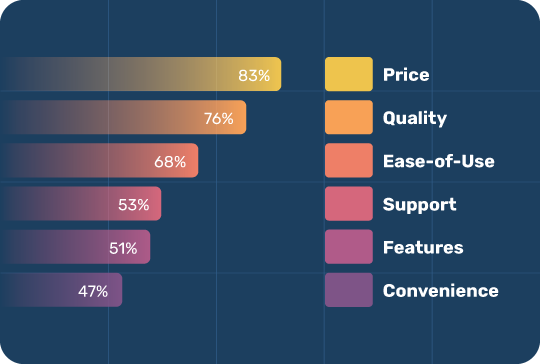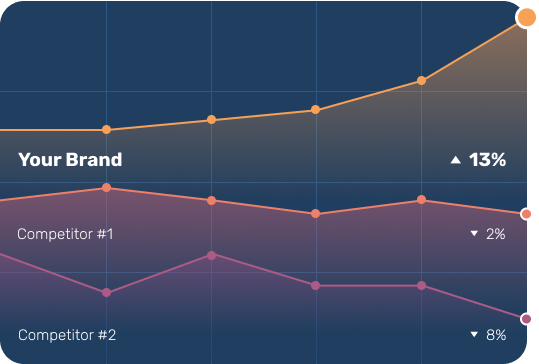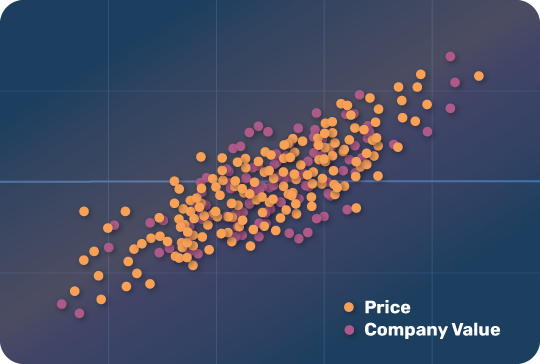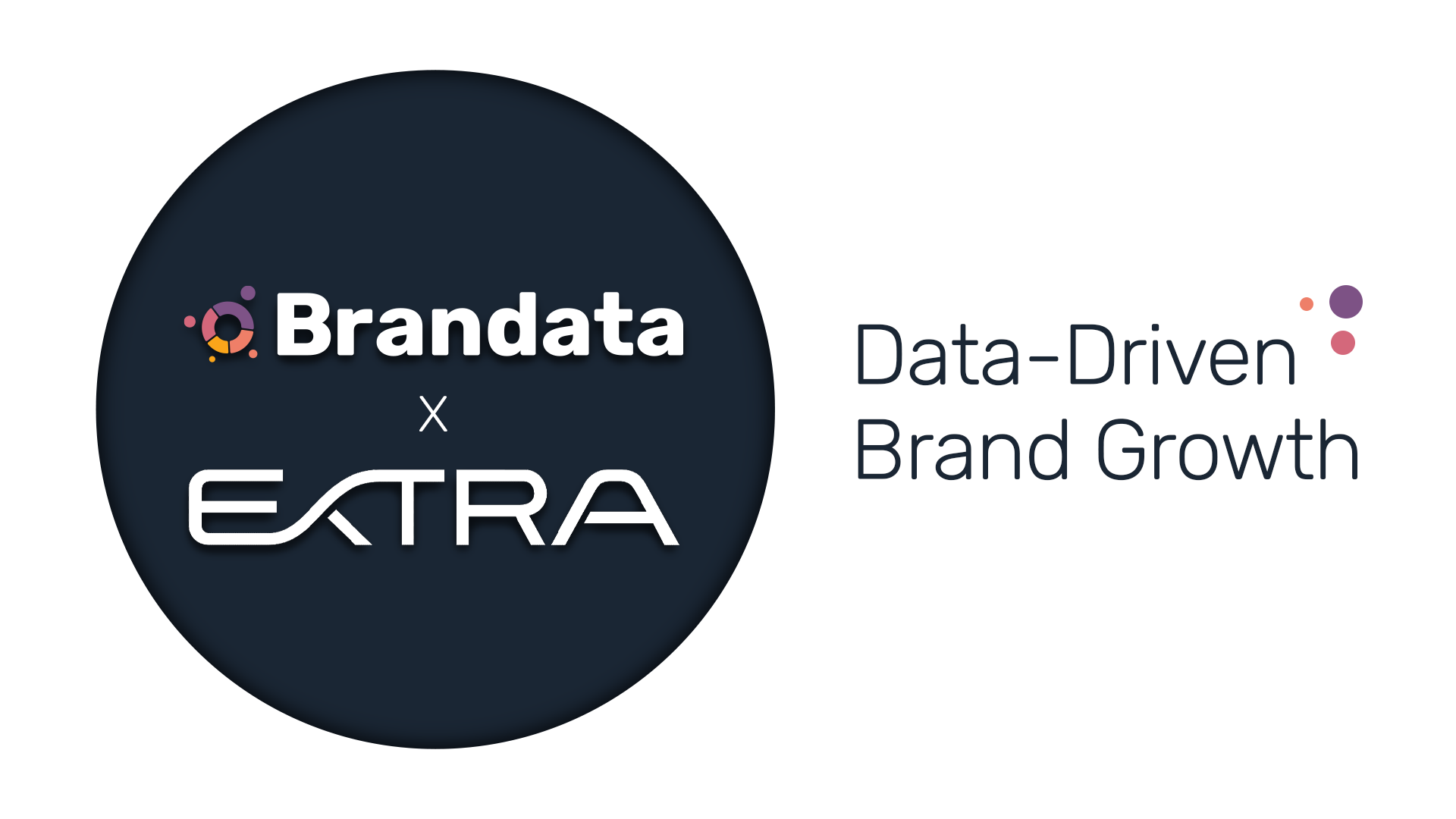In this complete guide to brand measurement, we'll explore various techniques and tools for assessing the performance and value of your brand. From initial brand research to brand equity analyses, this article covers everything you need to know to navigate the world of brand measurement effectively.
What is brand measurement and why is it important?
Brand measurement is a crucial aspect of modern marketing, as it helps businesses make data-driven decisions to optimize their brand strategies. A strong brand is essential for companies to differentiate themselves, build trust, and foster customer loyalty for long-term success. The primary types of brand measurement include brand tracking, brand lift, brand equity, and brand research. By implementing brand measurement initiatives, businesses can gain insights into their brand performance, identify opportunities for growth, and ultimately strengthen their brand's position in the market.

Now let’s dive into the intricacies of brand measurement and gain valuable insights to help drive your brand strategy in this 10-part guide:
The Comprehensive Guide to Brand Measurement:
- An Introduction to Brand Measurement
- The Importance of Brand Measurement
- Aligning Brand Measurement with Overall Business Goals
- Best Practices for Implementing Brand Measurement Initiatives
- Different Types of Brand Measurement
- Estimating Budgets and Costs for Brand Measurement
- Optimizing Your Marketing Efforts with Brand Measurement Insights
- Case Study: Extra's Approach to Brand Measurement
- Adapting Brand Measurement Strategies to Market Changes
- Brand Measurement in Conclusion
1. An Introduction to Brand Measurement
In today's highly competitive and rapidly evolving business landscape, a strong and distinctive brand has become more important than ever. McKinsey estimates that brands within a consumer’s initial consideration set are three times more likely to be purchased than other brands. Google’s own data points to brand signals as the most important factors that influence purchase decisions.
Companies need to differentiate themselves from the competition, build trust with their target audience, and foster customer loyalty to ensure long-term success. As a result, many businesses of all sizes are now investing in brand measurement—a powerful tool that helps them make objective, data-driven decisions around their brand strategy and ultimately grow their brand.

This comprehensive guide will delve into the critical role of brand measurement in driving business success. We will explore the importance of brand measurement and discuss its various types, including brand tracking, brand lift, brand equity, and brand research.
Additionally, we will cover best practices for implementing brand measurement initiatives, and provide a case study of a rapidly-growing startup’s approach to brand measurement. By the end of this guide, you will have a deep understanding of the role brand measurement plays in today's business landscape and how to use it effectively to strengthen your brand and achieve your objectives.
Before we continue, consider using our free Chat GPT-powered business case generator to build a strong argument for a brand measurement program within your own organization.
2. The Importance of Brand Measurement
A powerful brand is vital for companies looking to establish a competitive advantage, build trust with consumers, and foster customer loyalty. Brand measurement allows businesses to make objective decisions based on data, helping them to better understand their brand's performance and uncover areas for improvement. By doing so, companies can optimize their brand strategy and achieve greater success.

Brand measurement offers several key benefits for businesses:
- Align brand strategy with business objectives: By measuring various aspects of your brand, you can identify areas that align with your overall goals and work towards achieving them. This ensures your brand strategy is always in line with your business objectives and helps drive growth.
- Identify opportunities for improvement and growth: Brand measurement helps uncover potential weaknesses in your brand strategy, allowing you to address these issues and create a stronger, more successful brand. It also reveals opportunities for growth, enabling you to capitalize on them and expand your business.
- Measure the effectiveness of brand marketing initiatives: By monitoring the impact of your brand marketing efforts, you can determine which initiatives are driving results and optimize your campaigns accordingly. This helps you allocate resources more effectively and maximize the return on your marketing investments.
- Gain insights into consumer perceptions and behavior: Understanding how consumers perceive your brand and what drives their behavior allows you to tailor your messaging and marketing strategies more effectively. This leads to better engagement and a stronger connection with your target audience.
- Stay ahead of the competition: Regular brand measurement enables you to keep a finger on the pulse of your industry, ensuring you remain ahead of competitors. By staying informed about market trends and consumer preferences, you can adapt your brand strategy and maintain a competitive edge.
3. Aligning Brand Measurement with Overall Business Goals
Ensuring that your brand measurement initiatives align with your overall business strategy and objectives is crucial for maximizing their effectiveness and driving long-term growth. Here are the steps you can take to align your brand measurement efforts with your business goals:
- Identify your key business objectives: Start by outlining your company's overarching business objectives, such as increasing market share, driving revenue growth, or expanding into new markets. Having a clear understanding of your business goals will help you design brand measurement initiatives that support these objectives.
- Define relevant brand metrics: Identify the brand metrics that are most closely aligned with your business objectives. For example, if your goal is to increase market share, you may want to focus on metrics such as brand awareness, consideration, and preference. If your goal is to drive revenue growth, metrics like customer lifetime value, brand loyalty, and purchase intent may be more relevant.
- Set clear and measurable goals: Establish clear, measurable goals for your brand measurement initiatives that are tied to your business objectives. For example, you might set a goal to increase brand awareness by a specific percentage within a certain timeframe or improve brand loyalty by reducing customer churn.
- Align research methodologies with objectives: Choose research methodologies and data sources that best support your business objectives and the brand metrics you've identified. For example, if your goal is to better understand whether your overall awareness is increasing overtime, quantitative research methods like brand tracking surveys or brand lift experiments might be more appropriate than qualitative studies.
- Implement insights into business strategy: Use the insights gained from your brand measurement efforts to inform and refine your overall business strategy. This may involve adjusting your product or service offerings, marketing strategies, or target audience segments based on the insights you've gained.
- Monitor progress and adjust as needed: Regularly track the impact of your brand measurement initiatives on your business objectives and make adjustments as needed. This may involve refining your research methodologies, reallocating resources, or reevaluating your goals based on the insights you've gained.
- Communicate results to stakeholders: Keep stakeholders informed about the progress of your brand measurement efforts and their impact on your overall business objectives. This can help build buy-in and support for your initiatives, as well as demonstrate the value of brand measurement in driving business growth.

By aligning your brand measurement initiatives with your overall business goals and objectives, you can ensure that your efforts support and complement your broader business strategy. This alignment can help you make more informed decisions, optimize your marketing and branding efforts, and ultimately drive long-term growth for your company.
4. Best Practices for Implementing Brand Measurement Initiatives
In addition to the steps above, there are also a handful of best practices to consider when implementing a brand measurement strategy:
- Involve stakeholders in the process: Ensure that key stakeholders, such as senior management, marketing teams, and product teams, are involved in the brand measurement process. This will foster a collaborative approach to decision-making and help ensure that insights are effectively integrated into your brand strategy.
- Leverage advanced tools and platforms: Utilize advanced analytics tools and platforms to streamline the data collection and analysis process. These tools can help you derive valuable insights more efficiently and make more informed decisions to strengthen your brand.
- Be prepared to adapt your strategy: Brand measurement insights may reveal the need for changes in your brand strategy. Be prepared to adapt and evolve your strategy based on the insights you gain, and continually monitor and measure the impact of these changes.

- Set clear objectives: Before embarking on any brand measurement initiative, it's essential to establish clear objectives. Determine the specific goals you want to achieve, whether it's understanding consumer perceptions, identifying areas for improvement, or evaluating the effectiveness of marketing campaigns.
- Choose the right methodologies: Select the most appropriate brand measurement methodologies that align with your objectives. This may involve using a mix of quantitative and qualitative research methods to gain a comprehensive understanding of your brand's performance.
- Regularly track and analyze data: For brand measurement initiatives to be effective, it's crucial to regularly monitor and analyze your data. This will help you identify trends, uncover areas for improvement, and stay informed about market dynamics.
5. Different Types of Brand Measurement
There are four main types of brand measurement methodologies: brand research, brand tracking, brand lift and brand equity. It's essential to understand what each type entails and how they differ from one another. This will help you determine which methods are most relevant to your business and how you can leverage them to strengthen your brand.
Brand Research
Definition and purpose: Brand research encompasses a wide range of methodologies designed to gain insights into consumer preferences, market trends, and competitor activities, ultimately helping businesses refine their brand strategy. It’s the broadest category of brand measurement.
Gaining insights into consumer preferences and market trends: Brand research can reveal valuable information about your target audience's needs, preferences, and perceptions, as well as the competitive landscape in your industry.
Key methodologies and tools: Brand research can be conducted using methods such as surveys, focus groups, interviews, and market analysis.
How it helps businesses refine their brand strategy: By understanding the factors that influence consumer decisions and staying informed about industry trends, businesses can make more informed decisions about their branding efforts and create a more compelling brand strategy. Brand research is often highly customized to answer specific questions or solve known problems.

Brand Tracking
Definition and purpose: Brand tracking involves monitoring your brand's performance over time, focusing on metrics such as awareness, consideration, and sentiment. By tracking these key indicators, you can gain insights into your brand's health, monitor the progress of competitors and make informed decisions to improve its performance.
Key metrics and indicators: Some of the critical metrics measured through brand tracking include brand awareness (both aided and unaided), brand consideration, brand preference, and brand promoters score (bNPS). These metrics help paint a comprehensive picture of your brand's performance in the market and offer insights into areas that require improvement.
Methodologies and tools: Brand tracking typically relies on quantitative research methods, such as surveys, to collect data from your target audience. This data is then analyzed to determine trends and patterns in brand performance. Advanced tools and platforms can be used to streamline the data collection and analysis process, providing you with valuable insights more efficiently.
How it helps businesses make data-driven decisions: By regularly monitoring your brand's key performance indicators (KPIs) and identifying trends, you can make data-driven decisions to optimize your brand strategy. This enables you to address weaknesses and capitalize on strengths, ultimately driving business growth.

Brand Lift
Definition and purpose: Brand lift refers to the increase in consumer awareness, perception, or intent to purchase a product or service as a result of a specific marketing campaign. Brand lift studies are conducted to measure the effectiveness of these campaigns and help businesses optimize their marketing efforts.
Key metrics and indicators: Some crucial brand lift metrics include ad recall, brand awareness, brand consideration, purchase intent, and consumer sentiment. These metrics help businesses assess the impact of their marketing campaigns on their target audience.
Methodologies and tools: Brand lift studies typically involve a combination of pre- and post-campaign surveys or experiments to evaluate the change in consumer perceptions and behavior. Advanced analytics tools can be used to process and analyze the data, providing insights into the effectiveness of marketing initiatives.
How it helps businesses optimize marketing efforts: By measuring the impact of marketing campaigns on brand lift, businesses can identify which initiatives drive the most significant results and allocate resources more effectively. This helps maximize the return on investment (ROI) and optimize marketing efforts for better outcomes.

Brand Equity
Definition and purpose: Brand equity refers to the value that a strong brand adds to a company's products or services, as perceived by consumers. It is a crucial component of a brand's overall value and plays a significant role in driving consumer preferences and loyalty.
Key components and indicators: Brand equity consists of comparing components from brand lift or brand tracking studies, including brand awareness, brand associations, brand sentiment, and brand loyalty to key company metrics like revenue, market share and lifetime value per customer to understand the relation between brand and business value.
Methodologies and tools: Brand equity can be measured using advanced quantitative research methods, such as regression, clustering, and machine-learned predictive models. These tools can be employed to analyze the data and derive insights into the brand's overall value.
How it helps businesses enhance their brand strategy: By understanding the components of their brand equity and identifying areas of strength and weakness, businesses can make more informed decisions to enhance their brand strategy. This helps drive long-term growth and foster customer loyalty.

Next, let’s cover how to estimate the costs for a brand measurement program.
6. Estimating Budgets and Costs for Brand Measurement
Allocating an appropriate budget for your brand measurement initiatives is essential to ensure you can effectively collect, analyze, and act on the insights you gain. Here are some key factors to consider when estimating budgets and costs for brand measurement:
- Research methodology: The costs associated with various research methodologies can vary significantly. For example, conducting a large-scale survey may be more expensive than analyzing existing data from your marketing platforms. Consider the most suitable methodologies for your brand measurement needs and factor in the costs of conducting research, data collection, and data processing.
- Sample size and audience: The size of your target audience and the desired level of accuracy in your findings will influence the cost of your brand measurement efforts. Larger sample sizes generally result in more reliable insights but may require a higher budget to collect and analyze data.
- Frequency of measurement: Depending on your goals and objectives, you may need to conduct brand measurement initiatives at different frequencies. Frequent measurement efforts, such as ongoing brand tracking studies, will require a larger budget compared to one-time or ad-hoc studies.
- Use of external vendors: Engaging external research vendors or consultants to support your brand measurement initiatives may increase your costs. However, these experts can provide valuable insights and expertise that can help you optimize your efforts and maximize your return on investment.
- Technology and tools: Investing in the right technology and tools to support your brand measurement efforts, such as data analytics platforms and survey tools, can be a significant cost factor. Consider the potential return on investment when choosing which tools and technologies to invest in.
- Internal resources: Account for the time and resources your internal team will need to dedicate to your brand measurement initiatives. This may include time spent on planning, data collection, analysis, and implementing insights into your brand strategy.

It’s common for companies to spend between 5-10% of their brand budgets on measurement. To estimate your brand measurement costs, begin by outlining your objectives, desired research methodologies, and target audience. Assess the costs associated with each aspect of your brand measurement plan, including research, technology, tools, and internal resources.
At this point, you’ll likely have to make trade-offs between sample sizes, screening levels, number of studies, etc. to end up with a program that meets your objectives while staying cost-effective.
By carefully estimating budgets and costs for brand measurement, you can allocate resources effectively, optimize your efforts, and maximize the value of the insights you gain, driving long-term growth for your business.
Next, let's dive into the best practices for implementing brand measurement initiatives and how to leverage these insights to strengthen your brand.
7. Optimizing Your Marketing Efforts with Brand Measurement Insights
Once you've gained valuable insights from your brand measurement initiatives, it's essential to use this information to optimize your marketing efforts. Here are some practical ways to leverage brand measurement insights for more effective marketing:
- Refine your target audience: Brand measurement can provide insights into the demographics, behaviors, and preferences of your most engaged customers. Use this information to refine your target audience and create marketing campaigns that resonate with them.
- Improve your brand messaging: Identify areas where your brand messaging may be unclear or inconsistent, and use your brand measurement insights to make improvements. Ensure that your messaging aligns with your target audience's values and communicates your unique selling points effectively.
- Optimize your marketing channels: Analyze the performance of your marketing channels using brand measurement data to determine which channels are driving the most brand awareness, engagement, and conversions. Allocate your marketing budget more effectively by focusing on high-performing channels and optimizing those that need improvement.

- Enhance your creative assets: Use your brand measurement insights to identify which creative assets are resonating with your target audience and driving the desired results. Refine your visual identity, ad creatives, and content to better align with your audience's preferences and improve engagement.
- Test and iterate: Continuously test new marketing strategies, tactics, and creative assets based on your brand measurement insights. Use A/B testing and other experimentation methods to determine which approaches yield the best results, and iterate on your marketing efforts accordingly.
- Monitor campaign performance: Leverage your brand measurement data to track the performance of your marketing campaigns over time. Evaluate the impact of your campaigns on key brand metrics such as awareness, consideration, and loyalty, and use this information to refine your marketing strategy.
We’re getting close to the end of our guide to brand measurement. Next, we’ll explore how one fast-moving brand has leveraged brand measurement to accelerate its already rapid growth.
8. Case Study: Extra’s Approach to Brand Measurement
Extra, the first debit card that builds credit and earns rewards, understood the importance of leading with a strong brand to help disrupt the extremely competitive consumer financial product landscape.

To achieve this, they created a comprehensive brand measurement program in partnership with Brandata, utilizing a mix of brand research, brand tracking, brand lift, and brand equity methodologies.
Brand Research Project
Situation: Extra is focused on building credit for cardholders and helping them achieve their credit-related goals. With that in mind, they turned to brand experience research to better understand the credit goals of their cardholders, where the Extra debit card served them best and how to improve their product to make cardholders even happier.
Approach: Brandata designed and facilitated a brand experience survey using the industry-leading Qualtrics customer experience platform that explored cardholder goals, beliefs, behaviors and perceptions about the Extra brand and its role in their lives.
Results: The cardholder brand experience study revealed core insights around how cardholders thought about and used credit in their lives. The project helped solidify key decisions around pricing, product features and ideas for churn reduction.
Brand Tracking Project
Situation: Like most high-growth companies, customer acquisition costs, churn, and lifetime customer value are among the key performance indicators for Extra’s success. Their leadership team believed that a strong brand would pave the way for stronger outcomes in these focus areas, so they also launched a brand tracker to round out their key marketing metrics.
Approach: Brandata created and deployed a brand tracking study using Pollfish, a next-generation panel + survey provider well suited for many types of quantitative research. The team transformed the results in Google BigQuery, then surfaced the insights through a Google Slides presentation and a multi-page filterable Google Looker Studio dashboard.
Results: The comprehensive brand tracker provided insights across 15+ consumer data points and 20+ questions about consumer finance, Extra’s brand and its competitors, which were then leveraged across the organization to achieve customer success goals, hit marketing growth targets, as well as create further focus for the product roadmap.

Brand Lift Project
Situation: Extra’s innovative debit card doesn’t charge any fees and there’s never any interest charges because it works with their customers’ existing checking accounts. Instead, a subscription fee is used as the main revenue model for the startup. Their objective was to identify the ideal monthly and yearly subscription fee for Extra’s debit card.
Approach: Brandata designed and facilitated a pricing study with a Van Westendorp Price Sensitivity Meter approach using the Pollfish survey platform. In the study, respondents selected different price points at which Extra would be deemed inexpensive, expensive and optimal. The test was conducted with a control group and two test groups.
Results: After running the pricing lift study, Brandata recommended an optimal price range for Extra at their monthly and annual subscription levels for each plan type to help them serve more customers, increase their total addressable market and maximize their market share in the newly-created financial product category of debit cards that build credit.
Brand Equity Project
Situation: Extra’s rapid brand growth has allowed the brand to help thousands of consumers improve their credit scores and achieve more financial goals. In order to understand the degree to which their product helped their customers and to see if there were any drawbacks to using Extra, the company partnered with Experian and Brandata on a brand equity analysis.
Approach: Consumer data company, Experian, provided a dataset of ~10k consumers, half of which were Extra cardholders. Brandata then employed cloud-based machine learning tools and comparative analysis techniques to better understand how to further impact the credit situation and positive credit outcomes of Extra cardholders
Results: Extra’s cardholders were more likely to grow their credit, make new credit-based purchases, and demonstrate positive credit outcomes than average consumers. These insights were used to develop marketing claims, inform customer success strategies and create capabilities for AI-powered credit coaching functionality on the product roadmap.

Armed with these insights, Extra was able to make data-driven decisions to refine their brand strategy. They focused on enhancing their brand messaging, improving their product offerings, and optimizing their marketing efforts to better resonate with their target audience.
As a result, they experienced significant improvements in brand awareness, consideration, and sentiment, ultimately driving long-term growth for their business.
9. Adapting Brand Measurement Strategies to Market Changes
Getting a brand measurement program up and running is just step one. As you continue to leverage brand measurement insights to optimize your brand strategy, it's crucial to remain adaptable and responsive to market changes. Here are some key considerations to help you stay ahead of the curve:
- Monitor industry trends: Keep a close eye on emerging trends and shifts in your industry. This will help you stay informed about potential threats and opportunities, allowing you to make proactive adjustments to your brand strategy.
- Listen to your customers: Pay attention to customer feedback and sentiment. By understanding their changing needs and preferences, you can adapt your brand strategy to better meet their expectations and create a stronger connection with your target audience.
- Keep an eye on competitors: Regularly evaluate your competitors' branding and marketing initiatives to identify areas where your brand can differentiate itself and seize new opportunities.
- Stay agile and flexible: Be prepared to adjust your brand strategy as needed based on the insights you gain from brand measurement initiatives. Embrace change and be open to exploring new approaches and tactics to keep your brand relevant and engaging.
- Continuously innovate: Stay ahead of the curve by continuously innovating your products, services, and brand experiences. This will not only help maintain your competitive edge but also foster customer loyalty and attract new audiences.

10. Brand Measurement in Conclusion
In conclusion, brand measurement plays a critical role in today's business landscape, enabling companies to make data-driven decisions to strengthen their brand and achieve their objectives. By understanding the various types of brand measurement methodologies and implementing best practices, businesses can optimize their brand strategy, enhance customer loyalty, and drive growth.
If you’re building the case for brand measurement at your organization and would like some feedback, or if you’re looking for an experienced partner to facilitate a brand measurement program, don’t hesitate to reach out to our team of experienced brand measurement professionals for a consultation. We’re always excited to meet and serve the people behind today’s fastest growing brands and are looking forward to hearing from you.
(Editor's note: this article was created and edited by the author using ChatGPT-4).


